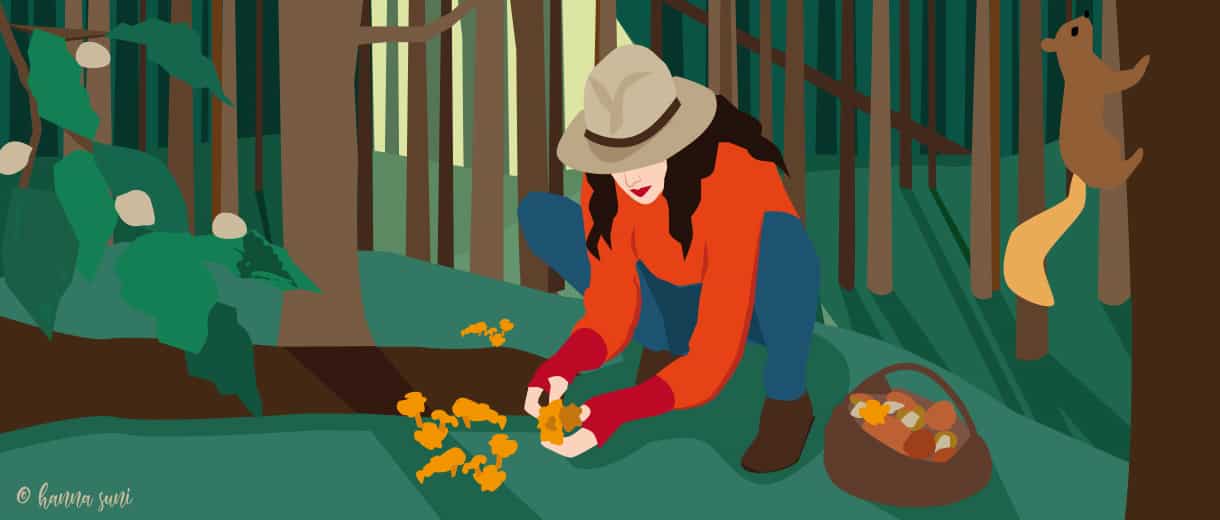Top Wild Fruits To Forage This Autumn
I’ve always really loved this time of year. Summer is effectively over, and the weather has thrown its usual late early September tantrum of stormy nights and chilly days. But always, as now, the sun returns for a couple of weeks at least. Under normal circumstances, this is always the time of year when I head off on my holidays to my beloved Calabria, in the south of Italy, extending the summer for as long as I can. But of course, this year, since it all went COVID and I’m really not up for travelling anywhere that involves leaving this beleaguered island, given that “the rules” seem to change with frankly de-stabilising volatility; I’m making the most of these cool early mornings and evenings, sandwiched either side of gloriously warm and sunny days. And I’m spending them happily out in the countryside on my regular foraging expeditions.
Getting ready for the foraging expeditions
This is the best time of the year to be out picking wild berries or gathering nuts and mushrooms. Wherever you are foraging, make sure you do it safely and sustainably and as far away from roads as possible to avoid traffic pollution. Foraging takes time, effort, and training to learn all you need to know about how to harvest wild fruits and nuts safely. In the case of the mushrooms, you really do need to know what you’re doing, and I would recommend you always take someone with you who can genuinely and immediately identify fungi species that are not edible.
After all, who can ever forget the dreadful story of Nicholas Evans, author of The Horse Whisperer, and the dramatic results of his fungi foraging expedition in 2008 on his brother in law’s estate? He picked them on a beautifully crisp and sunny autumn morning in a wood on Sir Alastair Gordon Cumming’s 13,000-acre Altyre Estate, in Forres, Moray Shire. But the mushrooms, lots of them, cooked in parsley and butter for lunch, were not edible ceps – Porcini – as everyone thought, but deadly Web Caps. Thirty-six hours later Nicholas, his wife and his brother in law were all in hospital and all three went on later to have kidney transplants. You really, really, really don’t want to take any risks with wild mushrooms!
However, if you do know what you are doing, they are some of nature’s greatest gifts. In this time of such extraordinary madness and instability, it is reassuring and somehow deeply soothing to immerse oneself in nature in this way, to then later enjoy the simple rituals of preserving these fruits of the season, not to mention eating and drinking the results! Just give it a try before the sun loses its heat and we settle into far shorter, darker days.
Into the woods
Wild berries and nuts, on the other hand, although not entirely devoid of risk, (some of them, like beechnuts, for example, can be slightly toxic if eaten in large quantities and you might mistake one red berry for another) are plentiful at this time of year. Easy to spot, they can be turned into all sorts of delicious treats and edible gifts for the winter months ahead.
Beechnuts
They are three-sided nuts in bristly cases. They are very popular with squirrels and badgers, so sometimes you might be up against some tough competition when it comes to finding them scattered around on the ground underneath a copse of beautiful beech trees. You can eat them raw, or they can be used just like pine nuts in salads and other dishes. Like Filberts or wild hazelnuts you can roast them in the oven in their skins and then rub them in a clean cloth to remove the skins before storing in airtight jars and using as required. I’ve yet to find pine kernels in this country – they nestle inside the open scales of big pinecones from specific pine tree varieties that mainly grow in the U.S., Asia and Europe, but I’m always on the lookout.
Blackberries
These wild fruits are almost over for this year, but if you are lucky enough to still find enough they are the perfect fruit with which to make jam – especially if you are something of a jam making virgin. High in pectin, they make a jam that sets beautifully with very little effort. Simply boil at a rollicking pace for about 10 to 15 minutes with the same or slightly less sugar than the weight of the fruit and a little lemon juice before potting up in sterilised jars.
Wild raspberries
They are a rare find, but if you are fortunate you will discover a very special fruit indeed – slightly more tart than their cultivated cousins, they can be used raw in exactly the same way or made into jam. You might also stumble upon the wild strawberry, which is tiny and equally rare – at best I have only ever found a small handful and their intense flavour and scent have made it difficult not to eat them all immediately on the spot.
Other wild fruits
In a riotous burst of orange and yellow, rosehips, haws and rowanberries flourish at this time and all of them can be turned into cordials, pickles and jellies to brighten up your kitchen shelves and given away as edible gifts come Christmas.
Apparently, the leaves of the hawthorn are just about edible, though I can’t say I’ve ever been tempted, but the berries (known as the haws) with their very dry flesh and large stone are worth picking and can be made into all sorts of interesting preserves and clear jelly. Best picked when fully ripe and deep red, the fruit is round and looks like a tiny little apple.
The seedpods of wild rose plants are called rosehips; their fleshy red or orange outer layer hides the hairy seeds that were once used to make itching powder so be careful when handling them! The flesh is packed with vitamin C and has long been used in helping to keep winter colds at bay. You can make wine, jam, jelly or syrup out of them – the dark pink syrup is delicious drizzled over a stack of pancakes. Be sure to wear stout gloves when picking these, as the thorny branches tend to fight back.
The Rowan is a tree that really stands out at this time of year, covered with bunches of vibrant, scarlet berries that are not only gorgeous to look at but that also have an intriguing and long-held association with folklore and witchcraft – red is the best colour to ward off evil. As a result of this belief, Rowan trees were often planted for protection near farms and houses and in churchyards. The lovely berries are really very bitter and are inedible raw, but when turned into jelly the result is a deep orange coloured concoction that makes a wonderful partner for roast lamb, or to serve with game or a cheeseboard.
Sloes are the purple fruit of the Blackthorn and although these are considered at their best after the first frosts when the skins soften, you can also pick them now and achieve the same effect by freezing them before use. Mainly used for making sloe gin – my local pub has an annual Best Sloe gin competition every year and if it takes place this year in these bizarre times I am thinking about entering. Apparently Sloe Whisky is also very good (I’m assuming you make it in the same way, i.e. by pricking the fruit and keeping it sealed in a jar with sugar and gin for about 3 months before straining and bottling.) Once bottled, it does improve over time, so this year’s batch should ideally not be drunk until next winter but in my house, it has never lasted that long.
By gathering these delicious wild plants with your own hands, you will feel like a part of nature and not just an observer; picking your own food will, in fact, restore the connection with the wilderness and the cycle of the seasons that are often lost in the modern world.
Like this article? Sign up to our newsletter to get more articles like this delivered straight to your inbox.


